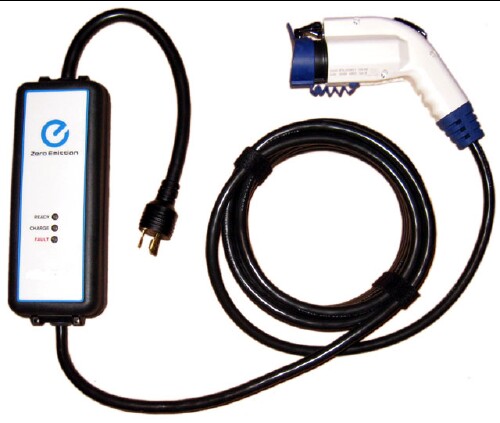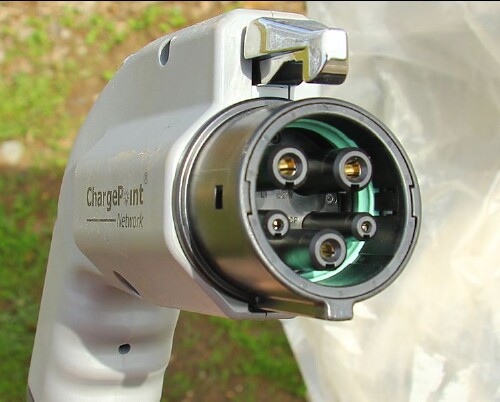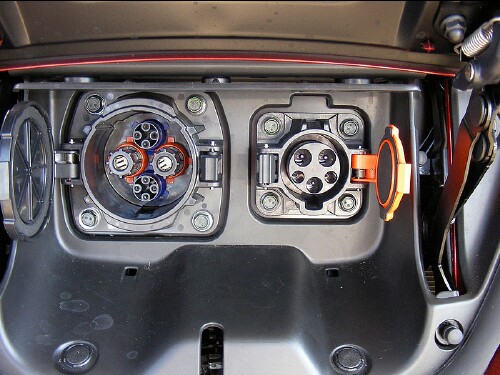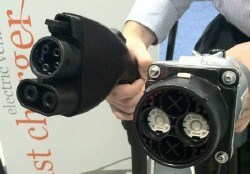 .
.L. David Roper
http://www.roperld.com/personal/roperldavid.htm
12 December, 2012
To reduce carbon put into the atmosphere that causes global warming automobile drivers need to switch from driving cars fueled by fossil fuels to electric cars. In order to encourage that transformation charging stations for electric cars need to be installed at strategic locations.
Most drivers of electric cars will have a level-2/240-volts charging station (see next section) in their garages or driveways, so that their need for such charging stations within about twenty-five miles of their residences is minimal. As explained below level-3/480-volts charging stations could prove useful within twenty-five miles of the residences of electric-car drivers.
So, the need for level-2/240-volts and level-3/480-volts charging stations (see next section) for a specific electric-car driver is at locations more than twenty-five miles from her residence.
This article describes the three levels of charging stations and lists the charging stations that are available and are needed in southwest Virginia and southern West Virginia.
There are three levels of charging stations for electric vehicles:
Standard household electrical outlets serve as this level of charging station. They provide about 1.14 kwh/hour. Electric cars vary
between 3.5 and 4 miles/kWh, so 1.14 kWh/hour will allow travel distance of 3.99 to 4.56 miles
for each hour of charging, Cars parked for many hours possibly can get enough
charge to travel back to their home locations. E.g., a completely empty Nissan LEAF parked
overnight for twenty hours could be full when it leaves. Some electric-car drivers use a 120-volts standard outlet in their garages/driveways as the method of charging their cars because they do not drive very far most of the time and they have plenty of overnight hours for charging.
Current mass produced cars provide a 25-feet cable for charging from a 120-volts standard outlet. Here is the one provided with the Nissan LEAF:
 .
.
This is the level-1 "trickle charging" cable that comes with the Nissan LEAF. It is called the Electric-Vehicle-Supply-Equipment (EVSE) cable. The box contains electronics to keep power from going into the rest of the cord until a connection has been made to the LEAF and to check for problems either in the source of power or the vehicle. There is a hole under the release handle in which a small 3/16"-shank pad lock can be inserted to prevent the release button from being pushed in to unplug it from the car. There is an aftermarket modification to the EVSE that allows it to plug into a 240-volts outlet to use it for level-2/240-volts charging. The 240-volts outlet needed is the NEMA-L6-20R. (See Upgraded Onboard EVSE for my Nissan LEAF.) Thus, the EVSE cable becomes a portable level-1/level-2 charging station (see next section). This revised EVSE LEAF cable can be used on all other current mass-produced electric cars besides the LEAF.
Standard 120-volts outlets are useful in airport long-term parking lots since electric cars are there for many hours, usually over one or more nights. They also are useful at hotels/motels for the same reason.
All mass-produced electric cars contain ports for the standard SAE-J1772 plug for level-1 and level-2 charging stations:

Electric cars have either a 3.3 kW charger (2012 LEAF and Mitsubishi i-MiEV) or a 6.6 kW charger (2013 LEAF and 2012 Ford Fusion EV). For a 3.3 kW-charger an hour of level-2 charging provides ~3.5 kWh; it is twice that for a 6.6-kW charger. So, a car that can go 3.8 miles/kWh can travel ~13.3 miles after one hour of 3.3-kW charging and ~26.6 miles after one hour of 6.6-kW charging. A completely empty 2012 Nissan LEAF can charge to full in ~6.5 hours; a completely empty 2013 Nissan LEAF will charge to full in ~3.25 hours.
Usually there is no charge for using a level-2 charging station. Some have a credit-card swipe, an RFID actuator or charge on-line by means of a smartphone app. Typically the fee for charging is $1/hour when there is a fee.
Some mass-produced electric cars contain ports for charging at level-3 charging stations. Here are the charging ports for the 2012 Nissan LEAF LS:

The port on the left is for level-3 (480-V, 125 A) charging; the port on the right is for level-1 (120 V, 15 A) & level-2 (240 V, 30 A) charging. The port for the right port is an SAE-J1772 standard port. The port for the left level-3 port is a CHAdeMO standard plug (up to 62.5 kW).

The plug on the left is the SAE level-1/level-2/level-3 combination plug and the plug on the right is the CHAdeMO plug for which a port is available on Japanese electric cars. Currently all level-3 charging stations in the U.S. are CHAdeMO.
A combined level-1/level-2/level-3 port is required for the SAE combination plug:

Probably future mass-produced electric cars in the U.S. will use this combination port. Probably there will be adapters to connect Japanese cars with the CHAdeMO plug to the SAE combination port and U.S. cars with the SAE plug to the CHAdeMO port.
A level-3 charging station can charge a Nissan LEAF from empty to 80% of capacity in ~30 minutes. Thus, the driver can get nearly a full charge while shopping and/or dining.
Both level-2 and level-3 charging stations can be used in the near future to recharge an electric car after it has been used for power backup at a home during a power outage at the home. Level-3 charging stations near the residences of electric-car drivers could be used for a quick charge when an electric-car driver suddenly needs to drive further than the current battey charge would allow.
Almost every eastern state except Virginia and West Virginia is installing level-3 CHAdeMO charging stations. Tennessee is the leader, followed by Illinois.
Unless stations are indicated as being level-1/120-volts outlets, stations listed are level-2/240-volts stations. There are many level-1/120-volts outlets not listed. They are ubiquitous; just ask to use one when you see it.
Most of the charging stations listed above are listed on http://www.plugshare.com.
A large effort needs to be made to install many level-2 charging stations and a few level-3 charging stations in southwest Virginia and southern West Virginia to increase the incentive for drivers to drive electric cars.
There are barely sufficient level-2 charging stations for an electric-car driver to drive between the Tennessee border and Roanoke/Blacksburg, but not enough for a trip between Roanoke/Blacksburg and Charlottesville. For the latter trip level-2 charging stations are needed at Lexington/Buena-Vista and Charlottesville, although the trip could barely be made through Lynchburg in a Nissan LEAF by using the Nissan charging stations near Lynchburg and in Charlottesville.
Both level-2 and level-3 charging stations can be used in the near future to recharge an electric car after it has been used for power backup at a home during a power outage at the home. Level-3 charging stations near the residences of electric-car drivers could be used for a quick charge when an electric-car driver suddenly needs to drive further than the current battey charge would allow.